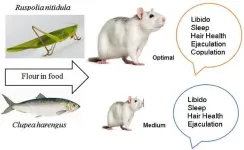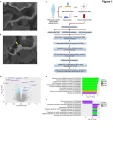(Press-News.org) HOUSTON – (Sept. 13, 2024) – Generative artificial intelligence (AI) has notoriously struggled to create consistent images, often getting details like fingers and facial symmetry wrong. Moreover, these models can completely fail when prompted to generate images at different image sizes and resolutions.
Rice University computer scientists’ new method of generating images with pre-trained diffusion models ⎯ a class of generative AI models that “learn” by adding layer after layer of random noise to the images they are trained on and then generate new images by removing the added noise ⎯ could help correct such issues.
Moayed Haji Ali, a Rice University computer science doctoral student, described the new approach, called ElasticDiffusion, in a peer-reviewed paper presented at the Institute of Electrical and Electronics Engineers (IEEE) 2024 Conference on Computer Vision and Pattern Recognition (CVPR) in Seattle.
“Diffusion models like Stable Diffusion, Midjourney, and DALL-E create impressive results, generating fairly lifelike and photorealistic images,” Haji Ali said. “But they have a weakness: They can only generate square images. So, in cases where you have different aspect ratios, like on a monitor or a smartwatch … that’s where these models become problematic.”
If you tell a model like Stable Diffusion to create a non-square image, say a 16:9 aspect ratio, the elements used to build the generated image gets repetitive. That repetition shows up as strange-looking deformities in the image or image subjects, like people with six fingers or a strangely elongated car.
The way these models are trained also contributes to the issue.
“If you train the model on only images that are a certain resolution, they can only generate images with that resolution,” said Vicente Ordóñez-Román, an associate professor of computer science who advised Haji Ali on his work alongside Guha Balakrishnan, assistant professor of electrical and computer engineering.
Ordóñez-Román explained that this is a problem endemic to AI known as overfitting, where an AI model becomes excessively good at generating data similar to what it was trained on, but cannot deviate far outside those parameters.
“You could solve that by training the model on a wider variety of images, but it’s expensive and requires massive amounts of computing power ⎯ hundreds, maybe even thousands of graphics processing units,” Ordóñez-Román said.
According to Haji Ali, the digital noise used by diffusion models can be translated into a signal with two data types: local and global. The local signal contains pixel-level detail information like the shape of an eye or the texture of a dog’s fur. The global signal contains more of an overall outline of the image.
“One reason diffusion models need help with non-square aspect ratios is that they usually package local and global information together,” said Haji Ali, who worked on synthesizing motion in AI-generated videos before joining Ordóñez-Román’s research group at Rice for his Ph.D. studies. “When the model tries to duplicate that data to account for the extra space in a non-square image, it results in visual imperfections.”
The ElasticDiffusion method in Haji Ali’s paper takes a different approach to creating an image. Instead of packaging both signals together, ElasticDiffusion separates the local and global signals into conditional and unconditional generation paths. It subtracts the conditional model from the unconditional model, obtaining a score which contains global image information.
After that, the unconditional path with the local pixel-level detail is applied to the image in quadrants, filling in the details one square at a time. The global information ⎯ what the image aspect ratio should be and what the image is (a dog, a person running, etc.) ⎯ remains separate, so there is no chance of the AI confusing the signals and repeating data. The result is a cleaner image regardless of the aspect ratio that does not need additional training.
“This approach is a successful attempt to leverage the intermediate representations of the model to scale them up so that you get global consistency,” Ordóñez-Román said.
The only drawback to ElasticDiffusion relative to other diffusion models is time. Currently, it takes up to 6-9 times as long for Haji Ali’s method to make an image. The goal is to reduce that to the same inference time as other models like Stable Diffusion or DALL-E.
“Where I’m hoping that this research is going is to define…why diffusion models generate these more repetitive parts and can’t adapt to these changing aspect ratios and come up with a framework that can adapt to exactly any aspect ratio regardless of the training, at the same inference time,” said Haji Ali.
⎯ by John Bogna
-30-
This news release can be found online at news.rice.edu.
Follow Rice News and Media Relations via Twitter @RiceUNews.
Peer-reviewed paper:
ElasticDiffusion: Training-free Arbitrary Size Image Generation through Global-Local Content Separation | The IEEE/CVF Conference on Computer Vision and Pattern Recognition 2024
Authors: Moayed Haji-Ali, Guha Balakrishnan and Vicente Ordóñez-Román
Project Page: https://elasticdiffusion.github.io/
Project Demo: https://replicate.com/moayedhajiali/elasticdiffusion
Project Code: https://github.com/MoayedHajiAli/ElasticDiffusion-official
Download associated media files:
https://rice.box.com/s/osmqdlteeox9e0v8ba2zxzvjvwxobycr
About Rice:
Located on a 300-acre forested campus in Houston, Rice University is consistently ranked among the nation’s top 20 universities by U.S. News & World Report. Rice has highly respected schools of architecture, business, continuing studies, engineering, humanities, music, natural sciences and social sciences and is home to the Baker Institute for Public Policy. With 4,574 undergraduates and 3,982 graduate students, Rice’s undergraduate student-to-faculty ratio is just under 6-to-1. Its residential college system builds close-knit communities and lifelong friendships, just one reason why Rice is ranked No. 1 for lots of race/class interaction, No. 2 for best-run colleges and No. 12 for quality of life by the Princeton Review. Rice is also rated as a best value among private universities by Kiplinger’s Personal Finance.
END
Rice research could make weird AI images a thing of the past
New diffusion model approach solves the aspect ratio problem
2024-09-13
ELSE PRESS RELEASES FROM THIS DATE:
NIH awards establish pandemic preparedness research network
2024-09-13
The National Institutes of Health (NIH) has established a pandemic preparedness research network to conduct research on high-priority pathogens most likely to threaten human health with the goal of developing effective vaccines and monoclonal antibodies. Currently, many of the diseases caused by these pathogens have no available vaccines or therapeutics, and investing in this research is key to preparing for potential public health crises—both in the United States and around the world. NIH’s National Institute of Allergy and Infectious Diseases (NIAID) expects to commit approximately ...
$3.9 million grant accelerates UVA professor's efforts to detect Alzheimer’s early
2024-09-13
University of Virginia professor Mathews Jacob has secured a $3.9 million grant to advance his innovative research on detecting Alzheimer’s disease in its early stages. Jacob, who specializes in electrical and computer engineering, is teaming up with researchers from the University of Iowa and the University of California-San Francisco to push the boundaries of imaging technology that tracks the brain’s metabolic changes — offering a fresh perspective on studying neurodegenerative disorders.
Their focus is on advancing magnetic resonance spectroscopic imaging (MRSI). Unlike standard MRI, which primarily highlights structural changes, ...
Flowers use adjustable ‘paint by numbers’ petal designs to attract pollinators
2024-09-13
Flowers like hibiscus use an invisible blueprint established very early in petal formation that dictates the size of their bullseyes – a crucial pre-pattern that can significantly impact their ability to attract pollinating bees.
The study, by researchers at the University of Cambridge’s Sainsbury Laboratory also found that bees prefer larger bullseyes over smaller ones and fly 25% faster between artificial flower discs with larger bullseyes – potentially boosting efficiency for both bees and blossoms.
Patterns on the flowers of plants guide insects, like bees, to the centre of the flower, where nectar and pollen await, ...
Men behind the wheel: Three times more violations and accidents than women
2024-09-13
Men are three times more likely than women to commit traffic violations while driving and to be involved in accidents. Moreover, they are more likely to create situations on the road that are highly dangerous to others. Men are also twice as likely to drive under the influence and nearly one-third more likely to receive a prison sentence for reckless driving. Perhaps it comes down to cultural norms and the different attitudes men and women have toward driving. These are the conclusions reached by Anton Kazun, Assistant Professor at the HSE Faculty of Economic Sciences, and Research Assistant Mikhail Belov.
There is a stereotype that women are worse driver than men; female drivers are ...
Research alert: Technique to study how proteins bind to DNA is easily misused; New study offers solution
2024-09-13
Researchers at University of California San Diego have published new guidelines that could help scientists significantly improve their results when quantifying the interactions between DNA and proteins. Understanding these interactions is critical to our understanding of human biology in general, and can also help scientists develop new treatments for a wide range of diseases, including many cancers.
The researchers focused on spike-in normalization, a widely-used molecular biology technique that helps ensure accurate and reliable results. Spike-in normalization involves adding a known quantity of chromatin (DNA and the associated proteins) to a sample before it ...
Edible insects show promise as sustainable nutritional source
2024-09-13
As the global population grows and traditional livestock production increasingly strains environmental resources, there is a rising interest in alternative protein sources. Edible insects, particularly grasshoppers, are abundant in regions like Cameroon and provide essential nutrients, including proteins, amino acids, and minerals vital for health and growth. Addressing these challenges calls for in-depth studies on the nutritional benefits of insects such as Ruspolia nitidula.
Conducted by the University of Dschang, Cameroon, and published (DOI: 10.26599/FSAP.2024.9240068) in the journal Food Science of ...
Machine learning could help reduce hospitalizations by nearly 30% during a pandemic, study finds
2024-09-13
A new study sheds light on a promising approach using machine learning to more effectively allocate medical treatments during a pandemic or any time there’s a shortage of therapeutics.
The findings, published today in JAMA Health Forum, found a significant reduction in expected hospitalizations when using machine learning to help distribute medication using the COVID-19 pandemic to test the model. The model proves to reduce hospitalizations relatively by about 27 percent compared to actual and observed care.
“During the pandemic, the healthcare system was at a breaking point and many health care facilities relied on a first-come, first-serve or a patient’s ...
E-cigarette brands are skirting the rules about health warning labels on Instagram
2024-09-13
Island breeze, blue lagoon, dew drop—these aren’t the names of scented candles on display at your local home goods store. They’re flavors of synthetic nicotine used in e-cigarettes, often advertised with neon-electric colors and bright lettering to make them look like boxes of candy or fruit juice. But underneath all the flair, a specific label written clearly in black text on a white background is required by law to be there: a warning that says the product contains nicotine and that nicotine is an addictive substance.
Even though health warnings need to be written on physical products sold in stores ...
Scientists discover potential cause of an enigmatic vascular disease primarily impacting women
2024-09-13
Mount Sinai researchers have identified a key driver of a blood vessel disorder known as fibromuscular dysplasia (FMD) which affects up to five percent of the adult population and can lead to high blood pressure, heart attack, or stroke.
In a study published September 13 in Nature Cardiovascular Research, the team said changes in the gene UBR4 played an important role as a key driver of FMD. They suggested the discovery could be an important step toward developing a therapeutic approach for the disorder.
“Although fibromuscular dysplasia was first recognized more than 80 years ago, until now ...
Stimulant, antidepressant, and opioid telehealth prescription trends between 2019 and 2022
2024-09-13
About The Study: From 2019 to 2022, overall prescription volumes for stimulant and antidepressant medications increased, while prescription volume for opioids decreased. Concurrently, the proportion of telehealth prescriptions climbed across medications, increasing by a factor of 188 in opioids and more than 20 for antidepressants. These findings align with existing research highlighting the shift toward telehealth and the rise in stimulant and opioid telehealth prescribing during the pandemic. While in-person prescribing remains the most common, increasing telehealth ...
LAST 30 PRESS RELEASES:
Scientists trace microplastics in fertilizer from fields to the beach
The Lancet Obstetrics, Gynecology, & Women’s Health: Taking paracetamol during pregnancy does not increase risk of autism, ADHD or intellectual disabilities, confirms new gold-standard evidence review
Taking paracetamol during pregnancy does not increase risk of autism, ADHD or intellectual disabilities
Harm reduction vending machines in New York State expand access to overdose treatment and drug test strips, UB studies confirm
University of Phoenix releases white paper on Credit for Prior Learning as a catalyst for internal mobility and retention
Canada losing track of salmon health as climate and industrial threats mount
Molecular sieve-confined Pt-FeOx catalysts achieve highly efficient reversible hydrogen cycle of methylcyclohexane-toluene
Investment in farm productivity tools key to reducing greenhouse gas
New review highlights electrochemical pathways to recover uranium from wastewater and seawater
Hidden pollutants in shale gas development raise environmental concerns, new review finds
Discarded cigarette butts transformed into high performance energy storage materials
Researchers highlight role of alternative RNA splicing in schizophrenia
NTU Singapore scientists find new way to disarm antibiotic-resistant bacteria and restore healing in chronic wounds
Research suggests nationwide racial bias in media reporting on gun violence
Revealing the cell’s nanocourier at work
Health impacts of nursing home staffing
Public views about opioid overdose and people with opioid use disorder
Age-related changes in sperm DNA may play a role in autism risk
Ambitious model fails to explain near-death experiences, experts say
Multifaceted effects of inward foreign direct investment on new venture creation
Exploring mutations that spontaneously switch on a key brain cell receptor
Two-step genome editing enables the creation of full-length humanized mouse models
Pusan National University researchers develop light-activated tissue adhesive patch for rapid, watertight neurosurgical sealing
Study finds so-called super agers tend to have at least two key genetic advantages
Brain stimulation device cleared for ADHD in the US is overall safe but ineffective
Scientists discover natural ‘brake’ that could stop harmful inflammation
Tougher solid electrolyte advances long-sought lithium metal batteries
Experts provide policy roadmap to reduce dementia risk
New 3D imaging system could address limitations of MRI, CT and ultrasound
First-in-human drug trial lowers high blood fats
[Press-News.org] Rice research could make weird AI images a thing of the pastNew diffusion model approach solves the aspect ratio problem





